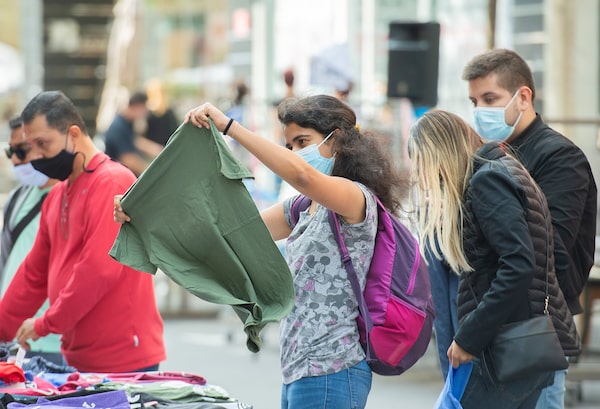
The challenge when treating shopping as leisure again is to avoid devolving into consumerism and putting want over need.Graham Hughes/The Canadian Press
The ability to quickly locate just about anything I want online is one of my superpowers. It’s also very boring. So when flea markets, libraries, bookstores and other physical retail spaces started welcoming in-person visits again, I was happy to resume meandering their aisles, unfettered and without obligation.
What I’m talking about isn’t really shopping. It’s browsing – and it’s a dying art. The pandemic has turned the social side of consumption on its head, but e-commerce was already chipping away at browsing’s small pleasures: sinking into the floor model of a potential new sofa to test its cushiness; working your way through a vintage store to assemble a perfectly mismatched set of tableware.
Outside of China, the time spent on retail apps globally increased by 45 per cent last year, according to App Annie’s State of Mobile 2021 report, which tracks mobile usage. Now that much of North America is in a phase of increased retail access, many stores are offering shopping by-appointment only to manage customer flow and ensure health and safety compliance. This means that discretionary shopping is often done with a sales associate in tow. The experience of being toured through a store can sometimes feel like the real-life version of what happens when you abandon your online shopping cart and are subjected to endless automated e-mails encouraging you to complete your purchase.
The middle class in the West hasn’t been without the luxury of browsing in a long time because browsing has been distinct from buying for more than a century. As Canadian journalist Pamela Klaffke explains in her book, Spree: A Cultural History of Shopping, it was the Bon Marché department store in Paris that first broke with tradition in the late 19th century. Previously, the cost of something was determined through haggling and whenever customers entered a shop, they were required to make a purchase. Suddenly, prices were fixed and browsing was encouraged.
The Victorians were the first to embrace hobby shopping and began the transformation of retail stores into gathering places and social salons. Experiential marketing pioneers such as Harry Selfridge saw that making shopping an entertaining activity often resulted in customers impulse-buying non-necessities.
“The simple pleasure of browsing without needing to buy anything has value in itself,” consumer psychologist Kate Nightingale writes in a recent Royal Society for Arts journal article about the soft, or indirect, benefits of in-person browsing. That pleasure may lead to a purchase, “but it does not change the fact that the motivation that brings a customer into the store in the first place often has nothing to do with needing to buy something and everything to do with the need to meaningfully connect and engage in a diverse collection of experiences,” she writes.
Those pleasures include random interactions with strangers who are also browsing and might offer a recommendation, share an anecdote or provide a tidbit of information. The e-commerce experience of digital purchases and contactless curbside pickups has been refined into an efficiently two-dimensional transaction, but it can’t offer the quality that is at the core of browsing’s allure: serendipity.
In June, the Center for Creativity and Innovation at Webster University Geneva held a conference that explored the intersection of creativity and serendipity. One of the talks was about the creative spark caused by these happy and unexpected discoveries. The act of browsing mimics this experience: catching a glimpse of something out of the corner of your eye; getting distracted and noticing things you weren’t actually looking for; and being inspired. Technology such as virtual and augmented reality can approximate aspects of the real-life shopping experience, but happenstance remains elusive online – so much so that digital marketers and consumer pundits call it the serendipity gap.
“Consumers are increasingly seeking serendipity in online shopping, where information clutter and preprogrammed recommendation systems can make product choice frustrating or mundane,” is how one 2018 information and management study about the serendipity deficit in online shopping environments put it. It may seem counterintuitive to plan for happy accidents to happen, but the easiest way to encounter those energizing instances of serendipity once again is by shopping in person and without a purchase commitment (aka browsing).
The challenge when treating shopping as leisure again is to avoid devolving into consumerism and putting want over need. “My golden rule is this: you’re never allowed to go shopping when you’re feeling bad about yourself or wearing clothing you don’t love,” activist Aja Barber cautions in her new book, Consumed: On Colonialism, Climate Change, Consumerism, and the Need for Collective Change. “It’s like grocery shopping when you’re hungry.”
Sign up for The Globe’s arts and lifestyle newsletters for more news, columns and advice in your inbox.